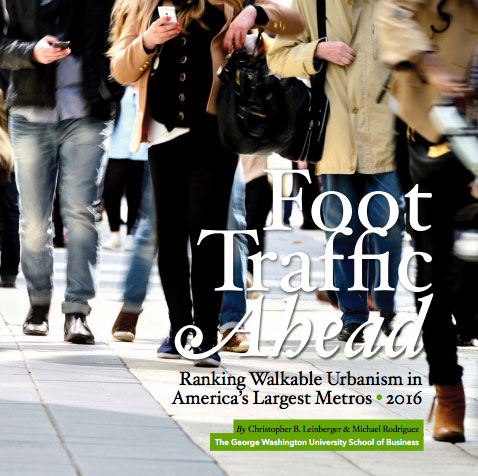
Authors
Publication Date
June 2016
Categories
Tags
Resource Type
Learn more about LOCUS
LOCUS is Smart Growth America's coalition of responsible real estate developers and investors. Learn more about their work ››
Foot Traffic Ahead: 2016
The end of sprawl is in sight. For perhaps the first time in 60 years, walkable urban places (WalkUPs) in all 30 of the largest metros are gaining market share over their drivable sub-urban competition—and showing substantially higher rental premiums.
Foot Traffic Ahead: 2016 shows that metros with the highest levels of walkable urbanism are also the most educated and wealthy (as measured by GDP per capita)— and, surprisingly, the most socially equitable.
Key findings
There are 619 regionally significant, walkable urban places—referred to as WalkUPs—in the 30 largest U.S. metropolitan areas. These 30 metros represent 46 percent of the national population (145 million of the 314 million national population) and 54 percent of the national GDP.
The 30 metros are ranked on the current percentage of occupied walkable urban office, retail, and multi-family rental square feet in their WalkUPs, compared to the balance of occupied square footage in the metro area. The six metros with the most walkable urban space in WalkUPs are, in rank order, New York City, Washington, DC, Boston, Chicago, San Francisco, and Seattle.
Economic performance
There are substantial and growing rental rate premiums for walkable urban office (90 percent), retail (71 percent), and rental multi-family (66 percent) over drivable sub-urban products. Combined, these three product types have a 74 percent rental premium over drivable sub-urban.
Walkable urban market share growth in office and multi-family rental has increased in all 30 of the largest metros between 2010-2015, while drivable sub-urban locations have lost market share. The market share growth for 27 of the 30 metros is two times their market share in 2010. This is of the same or greater magnitude as the market share gains of drivable sub-urban development during its boom years in the 1980s, but in the reverse direction.
Indicators of potential future WalkUP performance show that many of the metros ranked highest for current walkable urbanism are also found at the top of our Development Momentum Ranking—namely, the metros of New York City, Boston, Seattle, and Washington, DC. This indicates that these metros will continue to build on their already high WalkUP market shares and rent premiums.
There are also some surprising metros in this top tier of Development Momentum rankings, including Detroit, Phoenix, and Los Angeles. The most walkable urban metro areas have a substantially greater educated workforce, as measured by college graduates over 25 years of age, and substantially higher GDP per capita. These relationships are correlations, and determining the causal relationships requires further research to prove.
Walkable urban development describes trends resulting from both revitalization of the central city and urbanization of the suburbs. For nearly all metros, the future urbanization of the suburbs holds the greatest opportunity; metro Washington, DC, serves as a model, splitting its WalkUPs relatively evenly between its central city (53 percent) and its suburbs (47 percent).
Social equity performance
The national concern about social equity has been exacerbated by the very rent premiums highlighted above, referred to as gentrification. Counter-intuitively, measurement of moderate-income household (80 percent of AMI) spending on housing and transportation, as well as access to employment, shows that the most walkable urban metros are also the most socially equitable. The reason for this is that low cost transportation costs and better access to employment offset the higher costs of housing. This finding underscores for the need for continued, and aggressive, development of attainable housing solutions.